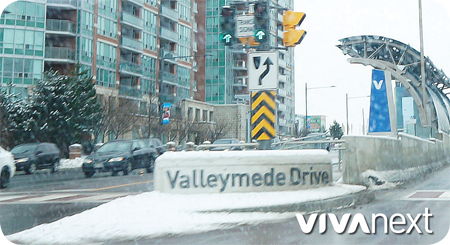If you’ve been at the corner of Jane Street and Highway 7 in Vaughan recently, you’ll have seen the work underway to build a 10 metre long retaining wall near where the Black Creek flows through a large culvert under the roadway.
We’re building the retaining wall to support the newly widened roadway. Ensuring that our project does not negatively affect any of the watercourses adjacent to or crossing our rapidway segments is a top priority for vivaNext, and we have made commitments through the Environmental Assessment phase of the project for how we will carry out that work to ensure there are no harmful effects. In keeping with this commitment, we need to have the major work on the retaining wall finished this spring before April 1, completing the in-water work before the closing of the pre-established work window.
This “work window” is set by the provincial Ministry of Natural Resources, and is set out in timing guidelines that are applied to construction projects near or in watercourses that are home to any species of fish. These timing guidelines are intended to protect fish from any impact from construction work being done in or around water, during the critical life stages for fish including spawning migrations, egg incubation and fry emergence.
Provincial guidelines are organized by region as well as by fish species within those regions. Fish can be divided into those that spawn in cold water (i.e. in the spring) and those that spawn in warm water (i.e. in the fall), with the species in the Black Creek being in the cold-water group. For that reason, the construction permits require that any work we do in or near the Black Creek be done outside of the period from April 1 to June 30, to ensure that the project doesn’t interfere with their spawning.
Once the work window closes April 1, we will not do any work in or around the water until the beginning of July. So we go to great lengths to ensure the work on the Black Creek retaining wall is finished by the end of March, and that we won’t need to do any other activities involving in-water work until the summer.
Our commitment to ensuring our work has no adverse effects on the environment goes well beyond avoiding any in-water work at sensitive times. On all our segments, we work closely with the local conservation authorities, who approve the final designs before we get their permission to work. Our mutual goal is to ensure the project, at a minimum, avoids any harmful impacts, and in many cases actively enhances the natural environment. We also use various construction strategies to mitigate any potential impacts while we’re working, such as installing cofferdams from sheet piles or sand bags around our work zones within watercourses. By using these methods, we’re able to work “in-the-dry”, thereby avoiding any risks to the watercourse and its fish, even if the in-water work window has closed.
We’re happy to know that the vivaNext project is going to ultimately enhance our shared environment for people and the other creatures that live in York. So taking great care as we work near our creeks and rivers is just one example of how we’re committed to protecting and enhancing our natural surroundings, even in a fully-urbanized area like Highway 7 and Jane Street.
Please remember as the temperature heats up during spring thaw, water ways and creeks can been extremely dangerous, remember to keep a safe distance.










